Seller Fulfilled Prime (SFP) & Premium Shipping Requirements Are Changing June 29, 2025: A Side-by-Side Deep Dive

Last updated on May 13, 2025

In this article
 7 minutes
7 minutes
- Trial Enrollment & Graduation Windows for Seller Fulfilled Prime
- Monthly Volume & Enrollment Requirements
- Size-Tier Misclassification & Network Disruptions
- Appeals Process Overhaul
- OTDR Protection via Amazon-Managed Shipping Tools
- Premium Shipping Changes
- Putting It All Together: A Seller’s Checklist
- Final Thoughts
Starting June 29, 2025, Amazon is rolling out tighter performance guardrails for two of its marquee shipping programs: Seller Fulfilled Prime (SFP) and Premium Shipping. Seller Fulfilled Prime work refers to the process by which eligible third-party Sellers can fulfill Prime orders directly from their own warehouses, provided they meet Amazon’s strict performance requirements. For Sellers, these changes aren’t mere tweaks; they reshape how you qualify, stay in, and recover from hiccups in these programs. Below, we’ll walk through each key requirement as it stands today versus what you’ll need to hit after the effective date, with real-world examples to illustrate exactly what’s at stake. For a rundown of all program requirements, see the full Seller Fulfilled Prime Program and Premium Shipping policies.
Trial Enrollment & Graduation Windows for Seller Fulfilled Prime
Today:
- You can request a 30-day SFP trial any time.
- The SFP trial period lasts for 30 days and includes specific performance metrics that must be achieved to qualify for official enrollment in the program.
- Graduation from trial depends solely on meeting performance metrics during those 30 days.
After June 29:
- Three Trials Max per Year: You’ll be capped at 3 trial attempts in each calendar year. Any trial that begins before June 29, 2025 doesn’t count toward this limit.
- Quiet Periods Around Major Events: If your 30-day trial spans the 30 days leading up to Prime Days, Black Friday through Christmas, etc., you cannot graduate. This ensures Sellers are battle-tested before the busiest season.
Sellers must successfully complete the trial period by meeting specific performance requirements to gain access to Prime branding.
Why This Matters: Imagine you enroll in an SFP trial mid-October, aiming to graduate in time for Black Friday. Under the new rule, even flawless performance won’t earn you Prime status, you’ll have to re-enroll after the holidays. Plan your trials for quieter times (e.g., late January) to avoid losing a precious attempt.
Slash Your Fulfillment Costs by Up to 30%
Cut shipping expenses by 30% and boost profit with Cahoot's AI-optimized fulfillment services and modern tech —no overheads and no humans required!
I'm Interested in Saving Time and MoneyMonthly Volume & Enrollment Requirements
Today:
- There’s no fixed minimum monthly SFP volume.
- If you miss on-time metrics, Amazon sends warning emails, but your enrollment status remains until metrics severely degrade.
After June 29:
- Minimum 100 SFP Shipments/Month: You must deliver at least 100 Prime-eligible packages each calendar month, spread reasonably across weeks, to maintain the Prime badge.
- Dynamic Order Limits: Fall below 100 (or cluster all shipments in one week), and Amazon will impose a reduced daily Prime order limit until you return to consistent volume.
- Exemption for Fix-Ups: If you get a second warning for missing any metric, you can pause Prime (no shipments) for a week to get your house in order, and that period won’t count against your enrollment.
Practical Example: You shipped 15 Prime packages in the first 3 weeks of May, then scrambled to ship 90+ in the final week. In June, you’ll wake up to find your Prime orders capped at a fraction of normal volume. Better to target 25–30 SFP orders per week and build in some slack.
Size-Tier Misclassification & Network Disruptions
Today:
- Listing ASINs in the wrong size tier might trigger warning emails, but rarely leads to immediate suspension. Misclassification can also result in higher storage fees, impacting overall profitability.
- Late deliveries during huge storms or carrier outages may or may not be excluded automatically.
After June 29:
- Strict Misclassification Guardrails: Repeatedly offering a product under the wrong size-tier can lead to blocking of SFP offers or Prime status suspension/revocation for those ASINs.
- Automatic OTDR Exclusions for Major Disruptions: Clearer language confirms that any late deliveries from Amazon-identified large-scale carrier or weather events are excluded from your OTDR automatically.
Scenario: You classify a product as having larger dimensions to qualify for the less strict performance requirements that apply to a larger size tier. After three such mistakes, Amazon silently blocks Prime on that ASIN. You’ll need to correct the tier and appeal to restore it—costly downtime.
Appeals Process Overhaul
Today:
- You have a sliding window to dispute removals, but timelines and submission limits are vague.
After June 29:
- 14-Day Filing Window: From the date you receive a notice (e.g., “Your SFP status is paused due to low OTDR”), you have 14 calendar days to open an appeal.
- 4-Day Response to Requests: If Amazon asks for more details, you have 4 days to reply, or your appeal is closed.
- Limit of 3 Appeals/Quarter: You can file up to 3 appeals per quarter (overturned appeals don’t count). Appeals require supporting data (order IDs, tracking numbers, ZIP codes, proof of carrier delays).
Why It’s Tougher: Say your OTDR dips because a regional carrier hub froze over two days. You’ll need to create a case including tracking scans, carrier advisories, and order logs quickly, or forfeit that appeal.
Looking for a New 3PL? Start with this Free RFP Template
Cut weeks off your selection process. Avoid pitfalls. Get the only 3PL RFP checklist built for ecommerce brands, absolutely free.
Get My Free 3PL RFPOTDR Protection via Amazon-Managed Shipping Tools
Today:
- If you use Amazon Buy Shipping and meet delivery cut-offs, late deliveries often still count against you unless you separately request exclusions.
After June 29:
- “OTDR Protected” Labels: If you enable Shipping Settings Automation in your Prime templates and purchase “OTDR Protected” labels through Amazon Buy Shipping, any late deliveries on Standard (for SFP) or Premium shipping won’t hurt your OTDR.
- Continued Exclusion of Major Disruptions: Same carve-out for large-scale network events.
Bottom Line: Automate shipping profiles and purchase labels using Buy Shipping API, and you effectively get “insurance” against minor late-delivery slips.
Premium Shipping Changes
Amazon’s Premium Shipping program (items promised in 1–3 business days) gets its own tightening:
|
Requirement
|
Today
|
After June 29
|
|---|---|---|
|
OTDR Threshold
|
97%
|
93.5%
|
|
Measurement Window
|
Rolling 30-day period
|
Weekly (Sun–Sat)
|
|
Enforcement Steps
|
Removal upon sustained dip
|
3-strike system:
1st miss – warning email 2nd miss – warning email 3rd miss in 4 consecutive weeks – removal |
|
Warning Reset
|
None
|
4 consecutive perfect weeks clears prior infraction
|
Key Impact: Under the new cadence, a single bad week can put you on notice, and three such weeks in a month spells immediate removal from Premium Shipping. You’ll need more consistent performance throughout each month, not just a healthy 30-day aggregate. Sellers must successfully complete the new performance metrics to maintain their status in the Premium Shipping program.
Scale Faster with the World’s First Peer-to-Peer Fulfillment Network
Tap into a nationwide network of high-performance partner warehouses — expand capacity, cut shipping costs, and reach customers 1–2 days faster.
Explore Fulfillment NetworkPutting It All Together: A Seller’s Checklist
- Schedule Your SFP Trial Smartly: Avoid major sale seasons; plan for Q1.
- Lock Down 100+ Prime Shipments/Month: Automate your SFP orders to spread volume evenly across weeks.
- Clean Up Your ASIN Tiering: Audit listings for correct size tiers and package profiles.
- Enable Shipping Automation + Protected Labels: In Seller Central > Fulfillment Settings, turn on SFP/Premium templates and default to OTDR-protected labels.
- Monitor Weekly OTDR: Invest in an operations dashboard that can track your OTDR by week for both SFP and Premium orders.
- Prepare an Appeals Kit: Create a template for submitting an appeal with sections for order logs, tracking scans, and carrier advisories so you can file within 14 days. Cases created after 14 calendar days will not be considered.
- Build in Buffer for Disruptions: If a regional snowstorm hits, pre-notify Amazon to be considered for exemption from performance defects proactively. Consider outsourcing your SFP fulfillment to a distributed fulfillment network that organically solves for carrier network disruptions and ensures the highest performance metrics for continued program eligibility and enrollment.
- Understand SFP Program Requirements: Familiarize yourself with the stringent requirements of the SFP program and adapt to changing Amazon policies to maintain your SFP status.
Final Thoughts
These new Seller Fulfilled Prime (SFP) and Premium Shipping requirements underscore Amazon’s push for ultra-reliable, ultra-consistent delivery, a win for customers, and a heavier lift for Sellers. But by meeting these new standards, (whether independently or with the help of a distributed fulfillment network), Sellers can maintain access to Prime branding and the substantial customer base of Amazon Prime members, mitigating the risk to the sales opportunities afforded by the Amazon Seller Fulfilled Prime Program.
By understanding the before-and-after, planning trial timing, automating wherever possible (especially Prime shipping options), and building a rapid-response appeals process, you can not only stay enrolled in SFP and Premium Shipping programs but thrive in them.
Watch the Video

Turn Returns Into New Revenue


